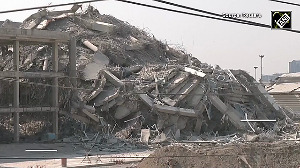Without a willingness to lug cheap flat-pack wardrobes home and wrestle with self-assembly, there would be no IKEA, but in Asia, where the locals have other ideas, the Swedish furniture giant thinks it still has a bright future. As it expands in China and prepares to break into India, IKEA Chief Executive Mikael Ohlsson trusts that its core concept, influenced by painstakingly acquired local knowledge, will, over time, give it an edge.
As it expands in China and prepares to break into India, IKEA Chief Executive Mikael Ohlsson trusts that its core concept, influenced by painstakingly acquired local knowledge, will, over time, give it an edge.
"Most people don't really know and can hardly imagine that we visit thousands of homes round every store in the world every year," he told Reuters at a store in Malmo in southern Sweden.
"We sit down in the kitchen and talk to them ... That's the way we try to learn and understand. 'What are you annoyed with? What are your frustrations? What would you like to have? How much can you afford? What are your alternatives?'" he said.
The group has already taken its huge out-of-town stores packed with modern Scandinavian style to 26 markets, with the product and experience instantly recognisable across them all.
But as it ventures further afield, it is tweaking its range and showrooms and adding services to accommodate new cultures.
One size doesn't fit all. In regions where apartments have smaller rooms, its showrooms have to be smaller. A sample balcony exhibit will be kitted out differently in northern China, where balconies are widely used for food storage, than in the south, where they often double as laundries.
Beds are bigger in the United States, but mattresses are firmer in China. And while stores will continue to carry about 10,000 products, the bulk of them from its standard range, the company stocks rice cookers and more chopsticks in the latter.
"As we become more and more global and we expand more in China and we grow into India, we will need, probably, to have a wider range," Gillian Drakeford, IKEA's China retail chief said.
"Then each country will be able to secure relevance by taking the part they really need. But of course we will still secure IKEA's identity."
Under One Roof
In developed markets, IKEA is positioned as a low-priced mass-market brand, but in emerging markets where low prices are the norm, it targets a growing middle class that aspires to international lifestyle products. For these customers, design and a comprehensive range under one roof are the attraction.
"They have numerous kinds and styles of furniture in one mall, mostly covering all the furniture I need," said Jane Wang, 21, an airport security inspector at an IKEA store in downtown Shanghai.
Price is much less a selling point in these new markets.
"IKEA loves little slogans like 'for the many people'. Those things are still true, but might be less true for some emerging markets," said Neil Saunders at retail consultancy Conlumino.
"As IKEA expands globally, the price of global expansion is that the company does become less cohesive."
Having more than doubled sales in the past decade to 27.6 billion euros ($36 billion) last year, the firm plans to double them again by 2020 and open 20-25 new stores a year from 2015.
Growth will mainly be in existing markets - in China it has reached 11 stores in about a decade and aims to triple that pace - but also in new; in India, where it is expecting the final go-ahead to enter soon, it has a plan for 25
Ohlsson expects it will take four or five years to open its first stores in India once it has the all-clear.
Ohlsson said IKEA was expanding its services for delivery, assembly and installation, as well as offering IKEA staff to get goods off the shelves for customers, very rare in mature markets. That is likely to be important for catching on in Asia.
"DIY works very well in Europe and the United States; they are used to it. If you look at markets like China and India, people are not used to DIY. That is a reason why Home Depot has failed in China," said Kantar Retail analyst Himanshu Pal.
"Indians have been used to local furniture shop owners making entire furniture units and delivering it to your house."
Knowledge Bank
Another issue for China has been the sheer volume of visitors, with 28,000 on an average Saturday in Beijing - roughly what a European store has in a strong week.
That means IKEA is building larger stores in China. It also builds them closer to customers, as fewer people have cars, and is likely to aim for the same in India.
"I'm not sure if I will want to travel to the end of the city to buy their furniture. Plus I have heard about how you are encouraged to pack your furniture up and then take it home and set it up yourself, and that is not something we Indians are used to," said Ridhika Mandavia, a playschool teacher in Mumbai.
"So if they can change that model and help pack and deliver furniture at no extra cost, it may work."
In China, buyers tend to buy lower-priced articles - last year the Beijing store was IKEA's biggest by volume, but only number nine by sales, Drakeford said.
IKEA finds red tape everywhere, but specific to India is the need for approval from state governments, and paperwork for transport between the highly autonomous states. The government also requires it to source 30 percent of its inputs locally.
When entering China, IKEA found itself more expensive than local low-priced firms, and only became profitable after big price cuts to come closer to the competition.
Prices there are now on average 50 percent lower than at the start. The classic Klippan sofa costs 999 yuan ($160), a third of what it did in 2002, against 2,995 crowns ($470) in Sweden.
Drakeford said IKEA's main advantage in a country with a growing urban population with Western aspirations, but little knowledge of Western styling, lay in its co-ordinated range and in presentation. "IKEA is their knowledge bank."
Turning a profit in India could also take time, but IKEA can afford to be patient.
"They have the financial strength to just bank upon sales growth without worrying too much about profit margins," said Kantar Retail's Himanshu Pal. "If they don't make money for the next two, three years, it does not become a huge crisis."












 © 2025
© 2025